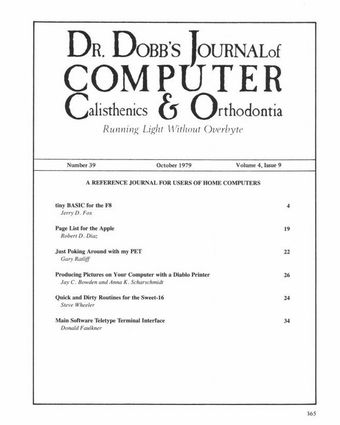
[author : Jerry D. Fox] #Listing #Assembly #BASIC
Extract : « Herewith is documentation and the source for a tiny BASIC Interpreter written for the F8 microcomputer. The structure of the program is copied from Palo Alto tiny BASIC written by Dr. Li-Chen Wang. It is to Dr. Wang’s credit that he wrote such an elegant program that it was fairly easy to convert to F8 from 8080 assembly language.
The program contains software stack so the nesting of GOSUB’s and FOR-NEXT loops can be accommodated. All I/O uses a monitor called FAIRBUG written by Fairchild. [...] »
[author : Robert D. Diaz] #Listing #MachineCode #Assembly #Algorithm #Display
Extract : « The Apple Computer prints on the TV screen at a rate of about 1,000 characters per second. However, most of the Apple users would prefer to read a listing at a slower rate. This article presents a solution to the dilemma: the Page List. The Page List (or listings by page) enables the Apple to list 20 lines of text, stop, and wait for a command from the keyboard to continue or to quit listing. [...]
I have chosen not to copyright this program in order to produce maximum distribution. It is my hope that most of the Apple owners will be able to utilize this program. Therefore, any person or group wishing to copy this program is more than welcome to do so. »
[author : Gary Ratliff] #Listing #BASIC #Programming
Extract : « There are two very simple procedures which may be used to obtain memory dumps on the screen. One method produces decimal values and the other ACSII values. Either form may be preferred, depending upon the end use of the information. Both methods may be used with either the BASIC Text RAM or the Operating System, with the exception of the BASIC Interpreter. [...] »
[author : Steve Wheeler] #Assembly #BASIC #Programming
Extract : « The Apple II computer contains in its firmware a 16-bit pseudo-machine called SWEET-16. A subroutine call to SWEET-16 causes all following code to be interpreted as instructions to the 16-bit pseudo-machine until a return to 6502 instruction (RTN) is encountered. SWEET-16 is a powerful adjunct to the Apple II computer, and several programs have been written for the Apple containing SWEET-16 code, including programs to renumber or to recover integer BASIC programs. Up until now, only Apple has had an assembler which would recognize SWEET-16 mnemonics, which meant that all other programmers have been forced to hand-assemble SWEET-16 code, and insert it into their programs as hex data. The following program is a modification to the cassette version of the S-C Assembler II which gives it the capability to recognize and correctly assemble SWEET-16 mnemonics. [...]
References
The Apple II computer is produced by the Apple Computer Company of Cupertino, California. The S-C Assembler II is available from S-C Software, P.O. Box 5537, Richardson, Texas 75080. The definitive article on SWEET-16 originally appeared in the November 1977 issue of BYTE magazine. »
[author : Jay C. Bowden and Anna K. Scharschmidt] #Electronic #Listing #BASIC #Graphics #Printer #OpticalInput #Book
Extract : « While hobbyists might like to experiment with digital image processing and recognition, most are prevented from doing so by the prohibitive expense of dedicated equipment, i.e., a scan converter camera and complex interfacing. But if you own, or have access to, a Diablo or similar type incremental printer, you already have the basis for beginning your own experiments in image enhancement and recognition. [...]
References
1. Gonzales, Rafael C. and Wintz, Paul A. : Digital Image Processing; Addison-Wesley, 1977
2. Hale, Jacques A.G. : Dot Space Modulation For The Production of Pseudo Grey Pictures; Proceeding of the S.I.D. Vol 17/2, Second Quarter 1976 pp. 63-74
3. McDonough, Tom: Computer Graphics With the Diablo; Creative Computing vol. 5, no. 6, June 1979 pp. 32-35 »
[author : David Morganstein] #Algorithm #Listing #Assembly #Interface #Networks
Extract : « Ever since acquiring a micro, one of my keen desires was to sign on to a main-frame and say “Hello.” Through my work as a statistician I have occasion to use the big-guys for one thing or another. Still, my micro hobby pushed me towards a two-way conversation. This article describes how I succeeded in setting up the OSI 430 Board RS232 interface so that I could connect to a modem, and then out the phone lines. [...] »
[author : Charles Wetherell] #Finance #Mathematics
Extract : « The naive view of programming is that it requires a great deal of mathematical skill and knowledge. Certainly logical analysis and deductive thinking are of value to programmers, but specific training in mathematics is not necessary. COBOL bears witness to this fact; it is the economically most important language and it is difficult to express anything more complicated than a division in COBOL. Occasionally, though, mathematics problems arise even in the most resolutely businesslike of programs. I would like to describe one such problem this month. [...] »
[author : Donald Faulkner] #Listing #Assembly #Interface
Extract : « This software is intended to allow operation of the Digital Group’s Z-80 system with an ASCII teletype (printer and keyboard). Basically a send and receive software UART, the routine is written to support teletype operation at 300 baud [...] »
[author : B. T. G. Tan] #Microprocessor #MachineCode
Extract : « The 6800 and 6502 microprocessors share many common features in their architectures, instruction sets, busses, and general system philosophy. I have compiled for teaching purposes a list of their common instructions and their addressing modes. This list is used in conjunction with a programming model which shows only the two MPUs’ common features (Fig. 1). The programming model has an 8-bit accumulator, index register, stack pointer and status register and a 16-bit program counter. Only 5 bits of the status register are used: carry/borrow, overflow, zero, negative and interrupt mask. [...] »